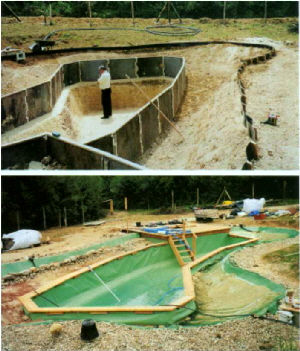- Natural Swimming Pools: (N.S.P.s) Chlorine Free, Swim Ponds
- Samples of Natural Swimming Pools (N.S.P.s)
- Artificial Rock/ Faux Rock
Pristine Swimming Written by Michelle Taute
Michael Littlewood is on a personal mission. The independent landscape architect has sent the last several years trying to convince England’s home owners they can enjoy safe backyard swimming sans all the harsh chemicals. So far it has been an uphill battle.
While there are an estimated 5,000 natural pools on the Continent that date back to at least 1985, Littlewood didn’t preside over the design and installation of England’s first chemical-free swimming pool until 2001. He teamed up with an environmentally minded family in Gloucester County and the Austrian firm Biotop to create a pool that mimics Mother Nature’s natural water-cleaning systems for rivers and lakes. Littlewood hopes U.S. designers will eventually follow his lead and champion natural pools in what potentially is the largest untapped market.
Littlewood now has an informal working relationship with BioNova, another firm that specializes in natural pools. (There are others, among them BioTeiche of Switzerland.) As a freelance landscape architect, he gained much of his pool knowledge through his own research and through training courses offered by a variety of organizations. Both Biotop and BioNova offer franchise arrangements to contractors– not designers. These professionals pay a one-time lump sum to the firm, as well as a percentage of the selling price of each pool they build. In return, contractors receive several days’ training, a handbook, and varying levels of continuing support.
The root of Europe’s sustainable pool design movement trace back to the work of Peter Petrich. This pioneering Austrian engineer was one of the first to try creating a water-purification system for pools (he founded Biotop in 1984) that relied largely on the cleaning properties of plants. Thanks in large part to Petrich’s early efforts, natural pools have now reached critical mass in Germany, Switzerland, and Austria, where there are successful examples in every imaginable shape and size.
A typical private pool is a minimum of 40 square meters in size and features one body of water separated into two zones– for swimming and water cleaning– by a wall concealed a few inches below the surface. The swimming area is 2 meters deep to help deter algae growth, and the cleaning or regeneration zone is between .2 and 1.3 meters deep. It’s the latter space where all the biological-cleaning action takes place.
Local water and marsh plants are based in a carefully constructed substrate. This planting bed consists of washed gravel, lime (to buffer pH), loamy sand, and nutrient bond. It’s usually one to one-and a half feet thick and must be capillary to accommodate plant roots and promote successful plant growth. While gravel and other substrata are key to the regeneration zone, the swimming area is left without gravel for easy cleaning in the off-season.
“The main water-cleaning activity takes place in the microorganisms and microbes– not the water plants,” says Rainer Grafinger, an engineer with BioNova. “We need the water plants to create a habitat for these elements.” As a pool’s mechanical circulation system pumps water through the regeneration zone, the substrate acts as a natural filter for any small particles in the water. The plants use nutrients from the water as food for themselves, which helps prevent algae and contributes oxygen to the system. Microorganisms and microbes break down potentially harmful molecules (pollutants) into basic elements.
Natural pools are closed ecosystems sealed by synthetic pool liners, which are made of heavy-duty rubber and protected by under liners. In addition to the mechanical circulation system, the pools have non-chemical filters to catch additional small particles. Plant selection varies from pool to pool. Some landscape architects consider plants more aesthetic than a technical choice. An average pool might include a mix of water lilies and leaf masses. 
Meredith Schneeweiss, who lives in the Austrian village of Maria Anzbach, has owned a natural pool for about six years, Schneeweiss’s husband vacuums the pool twice a year, and she tends to the plants on a semi-regular basis. “It’s like gardening,” she says. Although it costs about the same to install a residential natural pool as a traditional one, most owners find that they save on operation costs (no chemicals to purchase) and can do the majority of maintenance themselves.
“Every once in a while, we trim the plants and fish things out that have fallen in,” Schneeweiss says. Her 50-square-meter pool is home to irises in June, water lilies throughout the summer, and a rather loud frog chorus from the end of May until July. (Frogs and snakes are harmless to a natural pool, but such larger animals as fish, deer, and ducks would disrupt the system.) Besides creating a habitat for plants and animals, her pool is functional year-round: In the winter the frozen crust is perfect for ice-skating.
It’s that harmony– a seamless blending of environments– that natural-pool owners cite as a major benefit. “It has enriched our lives, Schneeweiss says. “While your separated from the plants, you still feel surrounded by them when you swim, which creates a very special kind of mood.” It’s the kind of devotion that has driven the steadily rising demand for natural pools in Europe.
 Perhaps even more impressive than Europe’s private chemical-free pools are the public ones. These sizable creations are subject to the European Union’s water-quality guidelines and offer the best evidence that chemical-free pools are viable. Germany alone boasts 30 public natural pools.
Perhaps even more impressive than Europe’s private chemical-free pools are the public ones. These sizable creations are subject to the European Union’s water-quality guidelines and offer the best evidence that chemical-free pools are viable. Germany alone boasts 30 public natural pools.
In the small town of Albstadt, residents enjoy a 1800-square-meter pool that’s cleaned by an adjacent pond of the same size that contains plants. Thomas Gerd, who heads up the city’s pool department, limited visitors to 1,000 per day during the first season, but he hopes to increase the swimming load to 2,000 this year if the cleaning pond works optimally. It often takes a few months for plants to really take root and reach full cleaning capacity.
“The water is tested every week by the public health department,” he says. “The quality we need is similar to drinking water.” Like the town’s residents, Gerd is a big fan of the pool. He describes maintenance as minimal; the main tasks include adding fresh water and cleaning up algae. It also cost the city significantly less to build a natural pool than to renovate the existing traditional one.
Albstadt’s pool was based on a two-pot design created by BioNova. The cleaning pond is completely separate from the swimming area, and water is pumped between the two water bodies to maintain cleanliness. This year BioNova will be involved in the publication of guidelines (in Germany only, unfortunately) for the planning, construction, and operation of natural swimming pools, as well as a book on the subject. Both should shed additional light on the intricacies of the chemical-free model.
In the United States, natural pools are likely to face the same initial skepticism that they have in England.
 If seeing is believing, it will take a few brave souls to get the ball rolling. There are also technical barriers to consider. Littlewood believes plant mixes may have to change to accommodate the wide variety of climate zones. Algae might also be more difficult to control in regions with very high temperatures. It seems likely that U.S. landscape architects will have to do at least some of their own research to address these and other issues.
If seeing is believing, it will take a few brave souls to get the ball rolling. There are also technical barriers to consider. Littlewood believes plant mixes may have to change to accommodate the wide variety of climate zones. Algae might also be more difficult to control in regions with very high temperatures. It seems likely that U.S. landscape architects will have to do at least some of their own research to address these and other issues.
Conservation Design Forum (CDF) in Elmhurst, Illinois, is in the midst of doing just that. The landscape architecture firm embraces sustainability and has a close working relationship with Atelier Dreiseitl in Germany, which has installed a number of natural pools. In addition, CDF is collaborating with a U.S. water-filtration producer on new products to use in its own chemical-free model.
“we’re on the verge of new products for these applications,” says Jim Patchett, ASLA, CDF’s president. “It could potentially revolutionize the industry and eliminate the use of chemicals in most pool applications.” Unfortunately, the firm is still in the process of finalizing a chemical-free system and declined to share details on an eventual approach or its new product development. CDF has, however, recommended natural pools for three upcoming projects.
This past year has also produced the first signs of interest in chemical-free swimming pools from the U.S. consumer market. Several lifestyle magazines featured the creations, and Mother Earth News, Issue 193, went so far as to suggest that people can build their own. (they give rather vague instructions and technical specs, available on the magazine’s web site.) Littlewood also receives a fairly steady stream of requests from the United States for more information on the topic. “I think a lot of people in the United States would like one, but they don’t know who to go to get it built,” Littlewood says. “We’re going to have to come over and show you how to do it.”
Call: (760) 505-7900 Email: bryan@expandinghorizons.biz
© 2018 Expanding Horizons is a part of the Omni Pragma® family All rights reserved.

